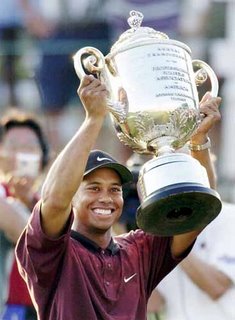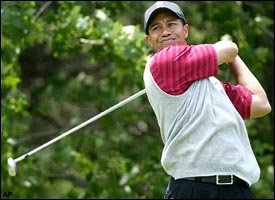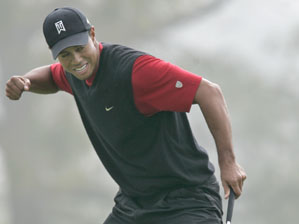Decade of Dominance

This week marks Tiger Woods 10th year on the PGA Tour, and what a decade it has been. His latest (4th consecutive) victory was also the 10th year anniversary of the day he turned professional. I can't believe it has been ten years already. After all, in that span of time, he has accumulated an amazing 52 victories, 12 majors and $63 million in earnings. When he turned pro, he was the one who grabbed all the headlines. 10 years later, he continues to be THE golfer to watch.
A week earlier, Woods won the PGA Championship for his 12th major, only six behind Jack Nicklaus' 18, a feat that Tiger Woods had always dreamed of surpassing. And at this pace, it seems like it would be inevitable.
Woods tied for 60th at the Greater Milwaukee Open in his pro debut 10 years ago this week. His first paycheck was $2,544. This year, he is averaging $2,512 for every stroke.
As fellow golfer Davis Love III says, "He's had the best 10 years in the history of golf. You knew he was a guy you were going to have to beat the rest of your career." Love was Woods first victim, losing a playoff to him in the 1996 Las Vegas Invitational, and there have been 46 other players who have finished second to Woods on the PGA Tour.
So began a decade of dominance that is defined by any set of numbers -- 52 wins, 12 majors, 142 consecutive cuts, the No. 1 ranking for 406 weeks, official victories in 12 countries.

Woods holds the scoring record to par in all four majors, and he is the only player to win all four professional majors in a row. He went seven years without missing a cut (142 events), and he has won 26 percent of his PGA Tour starts.
What really impresses me is how Tiger Woods strives to become better. Considering that he already was the best, how could he get even better? Thus, he already changed his swing a couple of times in the past decade.
When Woods turned professional in 1996, his swing already was mature but undisciplined. His distance control was spotty, as was his accuracy, but he could generate otherworldly club-head speed with a wide arc and pure athleticism, most notably a rapid hip turn. His dominating ’97 Masters victory, when he won by 12 shots and set the tournament scoring record of 270, was mostly the product, he admits, of a serendipitous week of tempo and timing.
Hence, he seeked the help of swing guru Butch Harmon, the same coach who helped Greg Norman become No. 1 in the 1980s and early 1990s. Harmon’s refinements, which were incorporated fully in 1998 even though the two had commiserated since ’93, helped Woods achieve an efficiency that defied the difficulties inherent in the game. In 2000, Woods won nine times, including the final three majors, and he never shot over par in any of his 20 TOUR starts. He set or tied 27 TOUR records, including a 68.33 non-adjusted scoring average (67.79 adjusted) that broke Byron Nelson’s 1945 mark.
 In spite of all these success, Woods departed the Harmon camp in favor of Hank Haney. The switch from Harmon to Haney didn’t appear to be all that good of an idea in 2004 when Woods won only one PGA TOUR event and saw Vijay Singh overtake him in the Official World Golf Ranking. But Tiger had his reasons for undertaking such a dramatic project in the prime of his career.
In spite of all these success, Woods departed the Harmon camp in favor of Hank Haney. The switch from Harmon to Haney didn’t appear to be all that good of an idea in 2004 when Woods won only one PGA TOUR event and saw Vijay Singh overtake him in the Official World Golf Ranking. But Tiger had his reasons for undertaking such a dramatic project in the prime of his career.
Woods thought that he could get even better. Haney was the longtime teacher of Mark O’Meara, Woods’ closest friend on the PGA. Haney believes that the best swingers of the golf club maintain symmetry from start to finish on one plane angle. The application of this theory to Woods’ swing made it more rounded and flat, and as Woods tried to incorporate this new method while fighting old habits, his accuracy and confidence waned, though he still continued to extend his record cuts streak through the alterations, a testament to his overall golf abilities and strength of will.
While the questions piled up in ’04, Woods maintained that he was satisfied with his decision. "Have I ever second-guessed it? No," he said in early ‘05. "I took some steps backward to go forward, to make some giant leaps forward."
Five wins and two majors last year vindicated the decision, and Woods has six more victories and two more Open and PGA titles to hang on his mantel in 2006, a year in which he missed his first cut as a pro in a major, at the U.S. Open, due almost entirely to the emotional trauma still tugging at him after his father’s death.
It’s the control, not his famed power game, that makes Woods so indomitable. And it’s control that drives Woods to continue to tinker with his swing, with Haney now his guiding influence.
In other words, Tiger Woods is still a work in progress. Scary...
Labels: golf, tiger woods


 design and layout by: radar web studios
design and layout by: radar web studios
<< Home